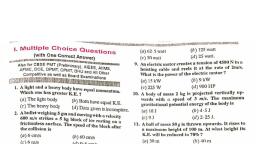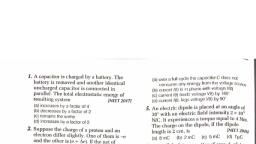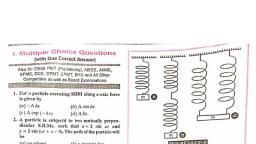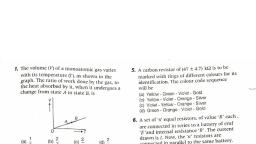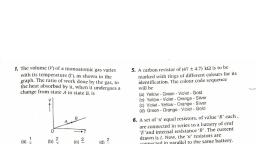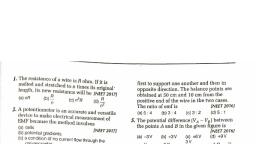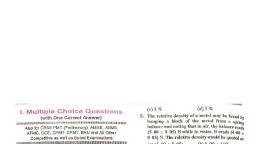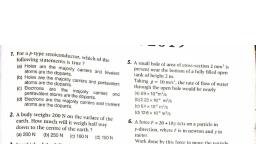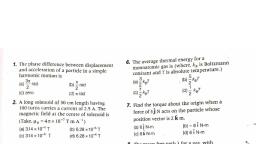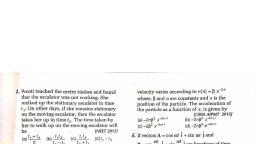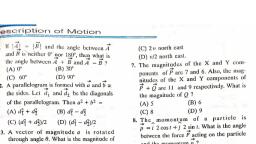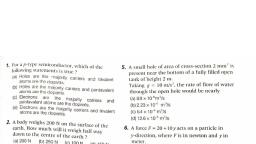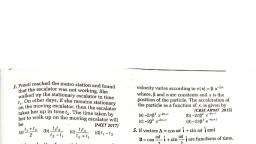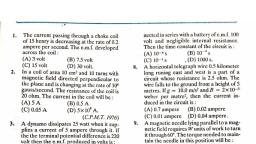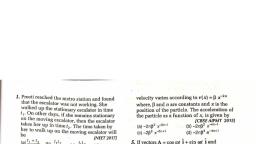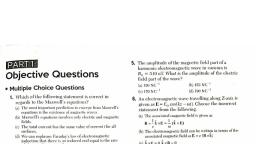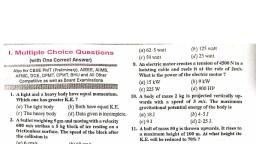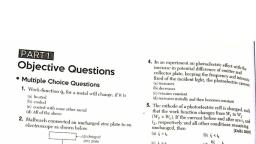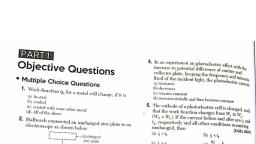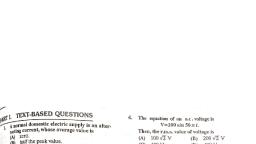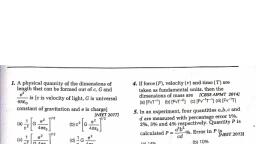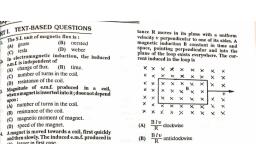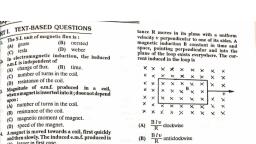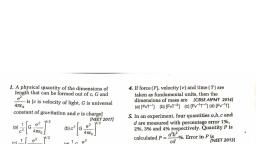Page 1 :
Chapter 2, , Nucleus & Nuclear energy, , , , , , PARTI. TEXT-BASED QUESTIONS, , Outside a nucleus,, , (A) neutron is stable., , (B) proton and neutron are stable., , (C) neutron is unstable., , (D) neither neutron nor Proton is stable., za energy equivalent of one atomic mass unit, , (A) 1-6x107 3 By 6-02 x 102, (C) 931 Mev (D) 9-31 MeV, (C.BS.E, 1992), , Nuclei having equal difference in the number, of neutrons und protons are called, , (A) isotopes (B) isobars, (C) isotones (D) isodiaspheres., (A.F.M.C. 1998), , The mass number of He is 4 and that ofsulphur, is 32. The radius of anys nucleus is larger, than that of helium by the factor of, , (A) 8 (B) vB, , (C) 4 (D) 2(C.B.S.E. 1995), The mass density of a nucleus varies with mass, number A as, , (A) A2 {B) A, (C) constant (D) 1A, (C.BS.E. 1992), , Order of the magnitude of the density of, uranium nucleus is [m, = 1-67 x 10~?7 kp), , , , on, , 11,, , (A) 10" kem73, , (B) 10" ky m3, (C) 10 kgm, , (D) 10" ke m7, (LLT. 1999), The origin of nuclear force is ascribed to the, , exchange of the following particle between a pair, of nucleons, , (A) mu-meson (B) z-meson, (C) electron (D) photon, , The binding energy per nucleon is almost con., stant for many nuclei. It shows that nuclear, forces are, , (A) short range in nature., , (B) attractive in nature., , (C) charge independent., , (D) saturated in nature., , Which of the following nuclei is most stable?, (A) odd-even (PA cven-odd :, (C) even-even 4D) odd-odd. |, The mass defect of an atom of mass M, atomic, number Z and mass number A is given by, , a M @) Ma, , (C) (A-Z)m,, , (D) [Zm,+(A-Z)m, + Zm,j-M, (Karnataka Entrance, 1992, 1988), , _ The packing fraction for 7N'* isotope, whose, , mass is 14-003 a.m.u,, is
Page 2 :
78% 107°) 21 JQ, , 4 1.0002 (D) 0-9, , ad, , (Karnataka Entrance, 1986, average binding energy ;, , atomic nUC leus is about, - 3 MeV (B) eV, (o) joule “, , (CBSE 1992), phe binding energy per nucleon is maximum in, "the case of, , (a) aH (B) a6Fe%, ic) soa . (D) us, (C.BS.E. 1993), , The mass defect for the nucleus of h, 0:0303 a.m.u. What is the bindin elium is, , ofa nucleon inside, , nucleon for helium in MeV? 8 energy per, aT (Bb) 7, (4 (D) 1, , (N.CE.RT. 1990), & The binding energies per nucleon fora deutron, and an a-particle are x; and x; respectively,, The energy Q released in reaction, i + pH? — ate + Q is, (A) 2(%) — x2) (B) 2% +.), (C) 4(x) +2) (D) 4 (2-2), (C.BS.E. 1995), 6 The binding energy of hydrogen atom is, (A) 1-0eV (B) infinite, (C) -—13-6eV (D) zero, (Karnataka Entrance, 1988), 1. Which of the following is a correct statement ?, (A) Beta rays are same as cathode rays., (B) Gamma rays are high energy neutrons., (C) Alpha particles are singly ionised helium, , Come tly the, (D) protons and neutrons have exac!, cree aon (LLT. 1999), , 1. If, 1; and 13 are ionising powers of a, f and, y-rays, then, , A) l>h>Is, , (Cy) h>hbuthk <I, (D) 1) <Ipbutl2> bb., , B) h<bh<b, , % Ina given reaction: a kit, aXe 9 VA —o gee, the radioactive radiations are emitted in the, Sequence of, (A) @,B,y (B) 7 a., () Bay (Dy) rhe, %, (CBSE, 1993; similar C.PM.T: 1990), , Complete the equation for the following fission, Process ;, , us + on! —_— ae” a 1, (A) sxe!" (By siXel +o”, , 21,, , 25., , 26,, , 27., , 1251, (©) sXe! 4 345! (D) Xe! + gn!, , (CASE, 1998), New huclew, , i, Ufter absorbing energy, decays, Into two d-particles and an unknown nucleus., ¢ unknown nucleus bs, , (A) nitrogen (B), , . carbon, (C) boron (D), , oxygen., , (LLT. 1999), Anucleus ,Y" emits one a and twofi-particles., The resulting nucleus is, As? om, , (Chi 5x4 Hn a”, (C.BS.E, 1998), , The radioactive nucleus 92U?™* emits an a, — and the doughter nucleus a f-particle., ¢ charge number and the mass of the final, nucleus are, , (A) 91,234 (B) 92,234, , (C) 90,234 (D) 93,234, After one a and two f-emissions :, , (A) mass number reduces by 2., , (B) mass number reduces by 4., , (C) mass number reduces by 6., , (D) atomic number remains unchanged., , (C.B.S.E. 1999), What is the respective number of a and f particles emitted in the following radio-active, decay?, eX —» gylet, (B) 6and6, (D) Sand6., (C.B.S.E. 1995), The halflife of I'*" is 8 days. Given a sample of, 1! attimer = 0, we can assert that, (A) no nucleus will decay before ¢ = 4 days,, (B) no nucleus will decay before ¢ = 8 days,, (C) all nuclei will decay before ¢ = 16 days., (D) agiven nucleus may decay at anytime after, 1=0. tL, , LT. 1998), In which radioactive disintegration, a neutron, , Is dissociated into a proton and an electron ?, (A) He** emission, (8) -emission., (C) y-emission,, , (D) positron emission, APMC., Half-life ofa radioactive inten ioleioanes, (A) the amcunt of element present,, , (B) temperature., , (C) pressure,, , (D) nature of material,, , (AEMC. 196: NCERT, hadi \NCERT. 19:, , imple with w halflife of 1, os label : ‘Activity = 2 feet wks 8 “oor, t was Its activity two months earlier ?, , (A) Gands, (C) Sands
Page 3 :
0,, , al., , 33,, , 36., , (A) LO pe (Hy OS peek, (C) dpe (DP) Byeei, , (CLS E, 1992), The decoy constant of radiouctive element, , radiom is 428% 100" year”! [ts hall life will, he, , (A) 2000 years (By 1240 years, , (CO) GV yeurs (DP) 1620 years, , (4.2 MC. 1998), If (4% of » radioactive material decays in, 5 days, then the amount of original material, left after 20 day ix approximately :, (A) 60% (B) 65%, (Cy) 70% (Dy 15%, (ALM, 1998), If the halflife period ofa radioactive substance, , is 225-8 min, then the value of the decay constant is, , , , (A) 3-1 107 min7!, , (B) 31x 10-4 minw!,, (Cy) 3-1 107° min!, (D) 3-1 107? min!, , (CBSE, 1999 | AUM.C. 1997), Hloif lives of two rudionctive substances A and, B are 20 min and 40 min respectively. Initially,, the samples of A and B have equal number of, , nuclei, After 80 min, the ratio of remaining, number of A and Eb nuclei is, , (Ay 1:16 (B) 1:4, (¢ 141 (D) 4:1, , (C.B.S.E, 1998), A radioactive element has half-life period 1600, , years. After 6400 years, what amount will, remain ?, , A) } (®) a5, ©) % m 4, , (C.B.S.E. 1993), After a time equal to five half lives, the amount of, radioactive material remaining undecayed is :, , (A) 20% (B) 10%, (C) 5% (D) 3%, , (A.PM.C, 1996; N.C.ER.T. 1990), The counting rate observed from a radioactive, source at’ = @ was 1600 counts ss! and at, (= 8s, itwos 100 countss~', The counting rate, (counts 87!) observed at¢ = 6 s will be, (A) 400 (B) 300, (c) 200 (D) 150, (MN R poor,
Page 4 :
57. Around disc of moment of i i, é nertia L,, its axis perpendicular to its i, passing through its centre is placed over, another disc of moment of inertia], rotating with an angular velocity w ‘about, the same axis. The final angular velocity of, the combination of discs is :, im jeose AIPMT 2004), a2 wo yO gt blo, hth heh ©) hr, , 58. The ratio of the radii of gyration of a, circular disc about a tangential axis in the, plane of the disc and of a circular ring of, the same radius about a tangential axis in, , the plane of the ringis [CBSE AIPMT 2004], (2:3 (oe) 2:1, (ce) V5. v6 (0) 1:2, , 59. A ball rolls without slipping. The radius of, gyration of the ball about an axis passing, through its centre of mass is k. If radius of, the ball be A, then the fraction of total, energy associated with its rotational energy, , will be. [CBSE AIPMT 2003], k Re ek ak, , cy a cL Ll, , Oa Rae “ fi ae, , 40. A thin circular ring of mass M and radius r, is rotating about its axis with a constant, angular velocity «. Four objects each of, mass m, are kept gently to the opposite, ends of two perpendicular diameters of the, ring. The angular velocity of the ring will, be, , , , {CBSE AIPMT 2003), (M+ amo (M = anyon, # ie © M+ 4am, Mo Mo, ¢) [im @ M+ 4m, 41. A rod is of length 3 m and its mass acting per, unit length is directly proportional to, distance x from its one end. The eno of, the rod from that end at, sii (CBSE AIPMT 2002], (a) 1.6m (ob)2m, (c) 2.5m (a) 3m, , 42. A solid sphere of radius F is placed ona, smooth horizontal surface. A horizontal, force F is applied at height h from the, , lowest point, For the maximum, acceloration of the centie of mass, , fahe ICBSE AIPMT 2002], (n=2R, (cjhed, (d) the acceleration will be same whatever fh, may be, , 43. A circular disc is to bo made using iron, and aluminium. To keep its moment of, inertia maximum about a geometrical axis,, it should be so prepared that, , {CBSE AIPMT 2002], (a) aluminium is at the interior and iron surrounds It, (b) iron is at the interior and alurninium surrounds it, (c) aluminnum and iron layers are in alternate order, (c) sheet af iron is used al both external surfaces, and aluminium sheet as inner material, , 44, A disc is rotating with angular velocity @. I, , achild sits on it, what is conserved ?, [CBSE AIPMT 2002), , (a) Linear momentum —{b) Anguiar momentum, {c} Kinetic energy (@) Moment of ineria, , . 45. A wheel of bicycle is rolling without, , slipping on a level road. The velocity of the, centre of mass is t,, then true statement, is [CBSE AIPMT 2001], , A, , (a) The velocity of point A is 2U¢y, and velocity of, point B is zero, , (b) The velocity of point A is zero and velocity of, point B is 2uey,, , (c) The velocity of point A is 2u,,, and velocity of, point Bis - Ucy, , (d) The velocities of both A and Bare Ucy, , 46. A particle of mass M is revolving along @, , circle of radius R and another particle of, , mass m is revolving in a circle of radius r, , If time periods of both particles are same,, , then the ratio of their angular velocities is, — {CBSE AIPMT 2001), , 7, , (a) 1 2 az
